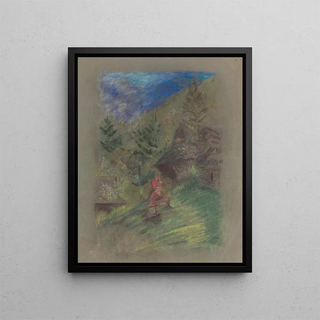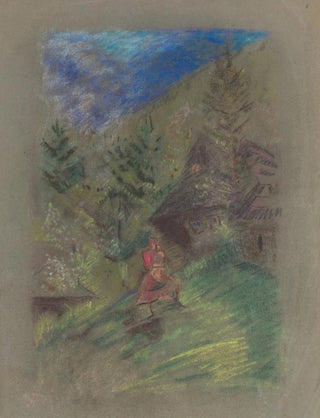Art print | Woman with a child in front of chalets - Arnold Peter Weisz-Kubínčan


View from behind

Frame (optional)
The artwork "Femme avec un enfant devant des chalets" by Arnold Peter Weisz-Kubínčan is an iconic piece that transports viewers into a world filled with tenderness and serenity. The scene depicts a mother and her child, central figures in a composition that evokes both maternal affection and the beauty of mountain landscapes. This painting, through its peaceful atmosphere, invites contemplation and reflection, showcasing the artist's mastery in capturing simple yet emotionally charged moments of life. The work is rooted in an artistic tradition that celebrates everyday life, while incorporating naturalistic elements that highlight the unbreakable bond between man and nature.
Style and uniqueness of the work
Weisz-Kubínčan's style is characterized by a realistic approach, where every detail is carefully observed and rendered. The color palette chosen by the artist evokes warm, earthy tones, creating a welcoming and harmonious ambiance. The chalets in the background, painted with meticulous precision, add a narrative dimension to the piece, suggesting a simple and authentic rural life. The posture of the woman and the expression of the child reflect palpable intimacy, strengthening the emotional connection between them. This painting does not merely depict a domestic scene; it invites immersion into a universe where nature and family life intertwine delicately, making each gaze an invitation to explore human emotions.
The artist and his influence
Arnold Peter Weisz-Kubínčan, a Slovak-born painter, established himself in the 20th-century art scene thanks to his unique sensitivity and commitment to representing everyday life. Influenced by the realist movement, he transcended the conventions of his time by integrating elements of popular culture and folk traditions into his works. His ability to capture the essence of ordinary moments while imbuing them with emotional depth has influenced many contemporary artists. Weisz-Kubínčan also played a key role in promoting Slovak art.

Matte finish

View from behind

Frame (optional)
The artwork "Femme avec un enfant devant des chalets" by Arnold Peter Weisz-Kubínčan is an iconic piece that transports viewers into a world filled with tenderness and serenity. The scene depicts a mother and her child, central figures in a composition that evokes both maternal affection and the beauty of mountain landscapes. This painting, through its peaceful atmosphere, invites contemplation and reflection, showcasing the artist's mastery in capturing simple yet emotionally charged moments of life. The work is rooted in an artistic tradition that celebrates everyday life, while incorporating naturalistic elements that highlight the unbreakable bond between man and nature.
Style and uniqueness of the work
Weisz-Kubínčan's style is characterized by a realistic approach, where every detail is carefully observed and rendered. The color palette chosen by the artist evokes warm, earthy tones, creating a welcoming and harmonious ambiance. The chalets in the background, painted with meticulous precision, add a narrative dimension to the piece, suggesting a simple and authentic rural life. The posture of the woman and the expression of the child reflect palpable intimacy, strengthening the emotional connection between them. This painting does not merely depict a domestic scene; it invites immersion into a universe where nature and family life intertwine delicately, making each gaze an invitation to explore human emotions.
The artist and his influence
Arnold Peter Weisz-Kubínčan, a Slovak-born painter, established himself in the 20th-century art scene thanks to his unique sensitivity and commitment to representing everyday life. Influenced by the realist movement, he transcended the conventions of his time by integrating elements of popular culture and folk traditions into his works. His ability to capture the essence of ordinary moments while imbuing them with emotional depth has influenced many contemporary artists. Weisz-Kubínčan also played a key role in promoting Slovak art.






